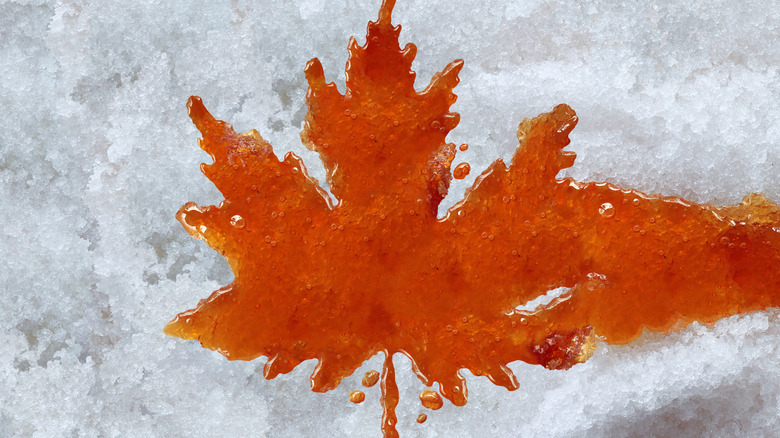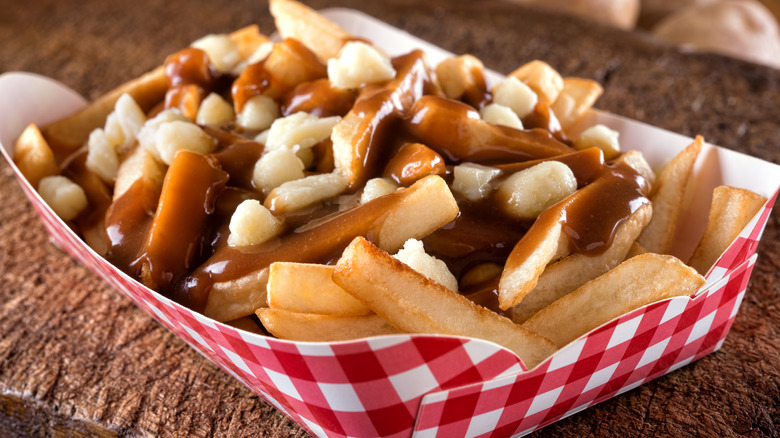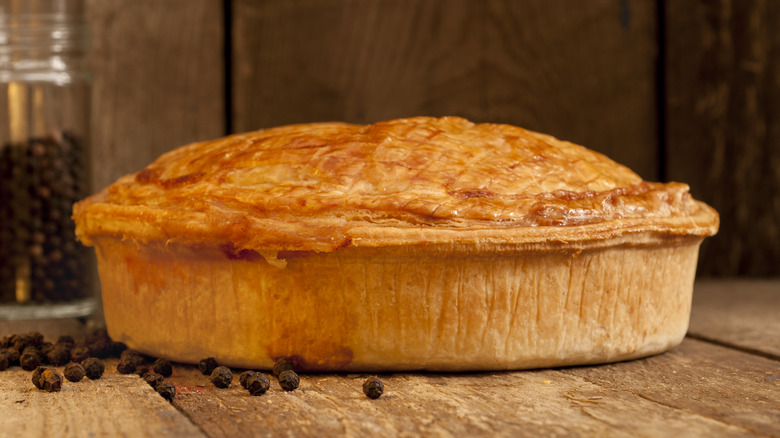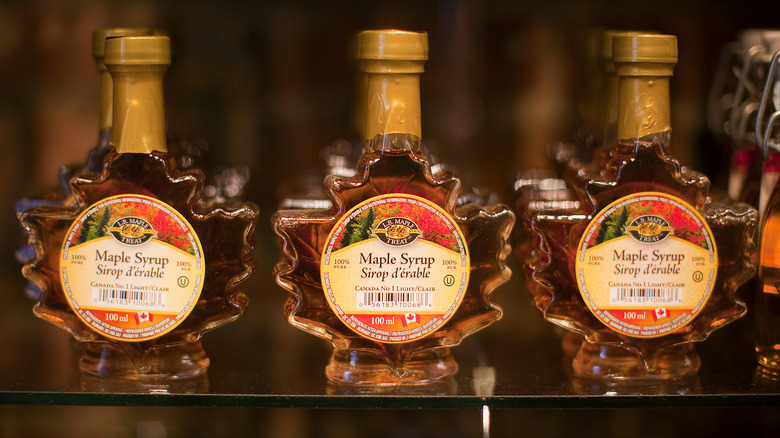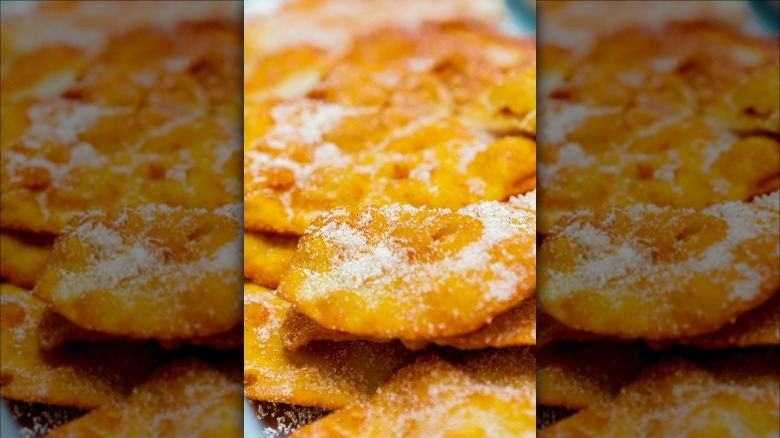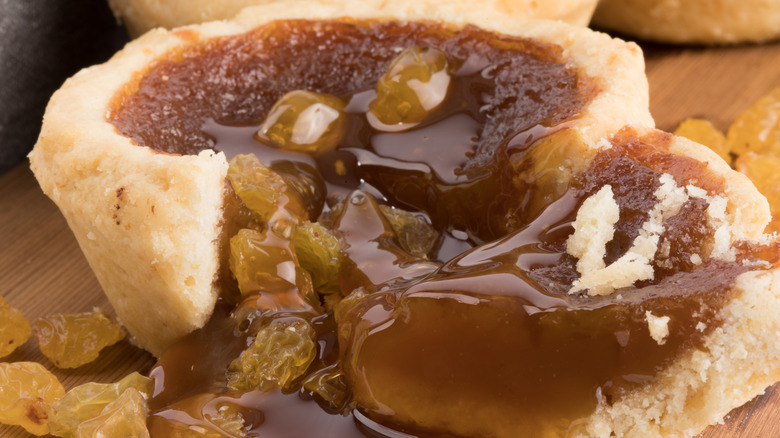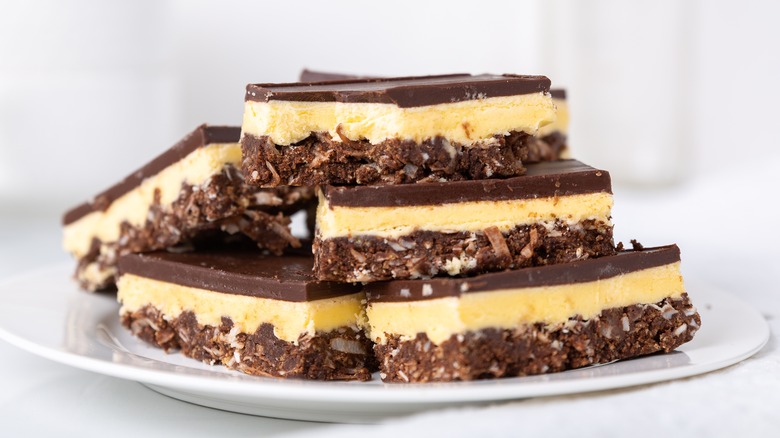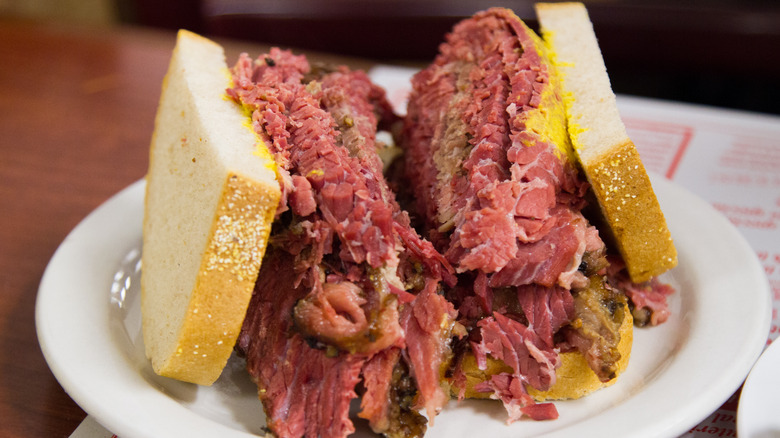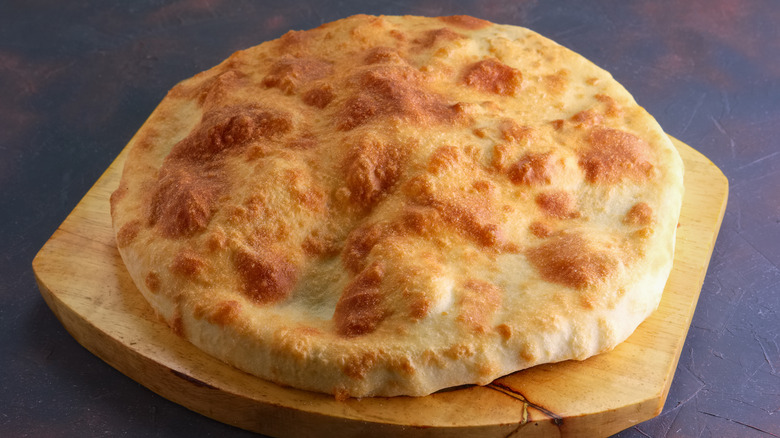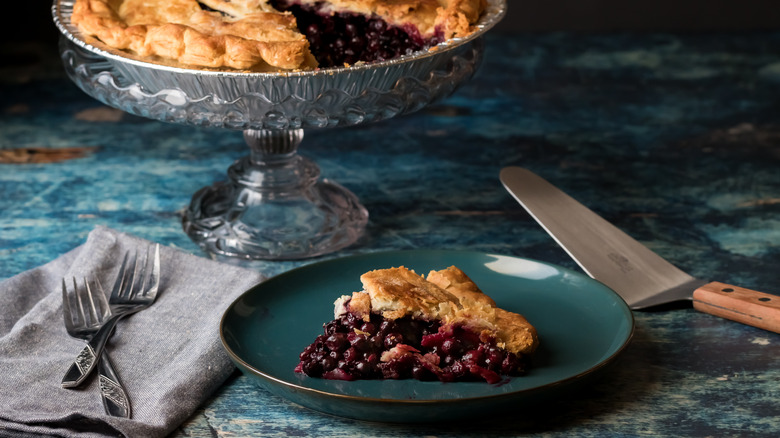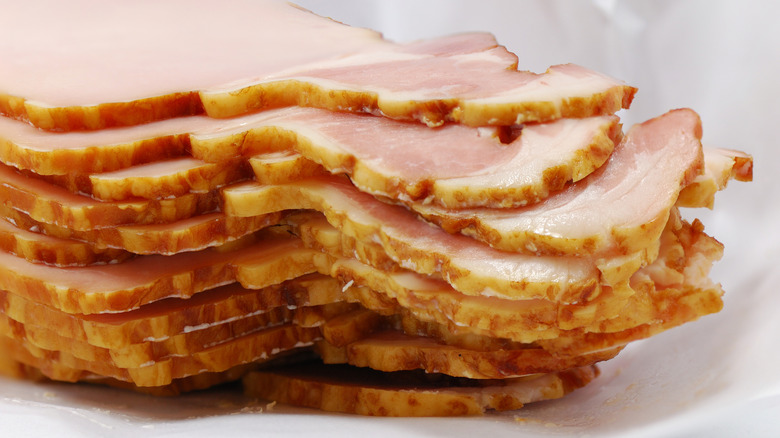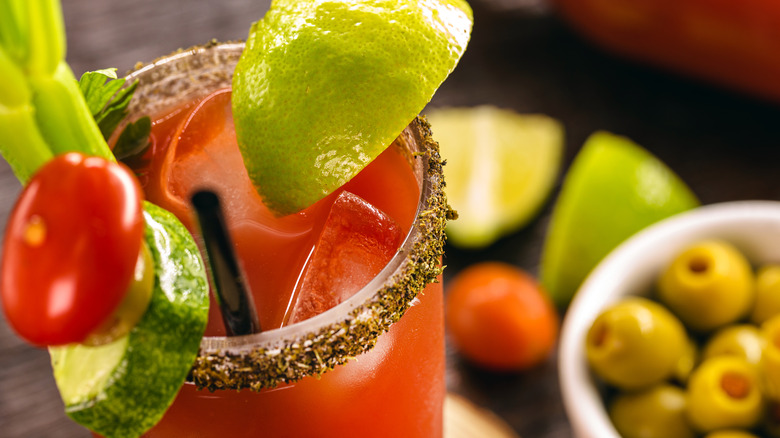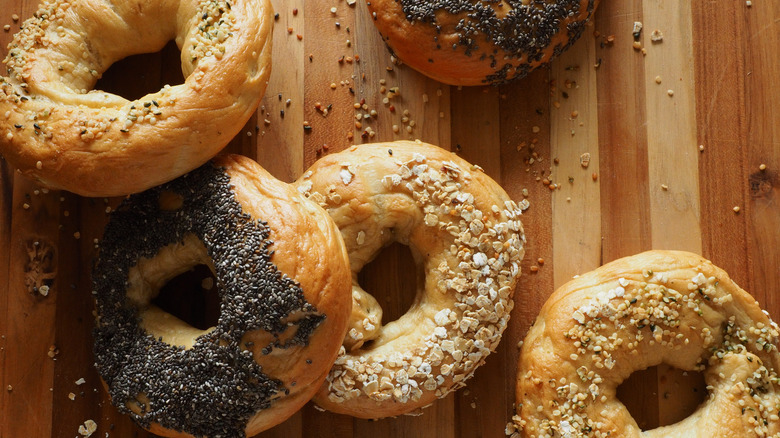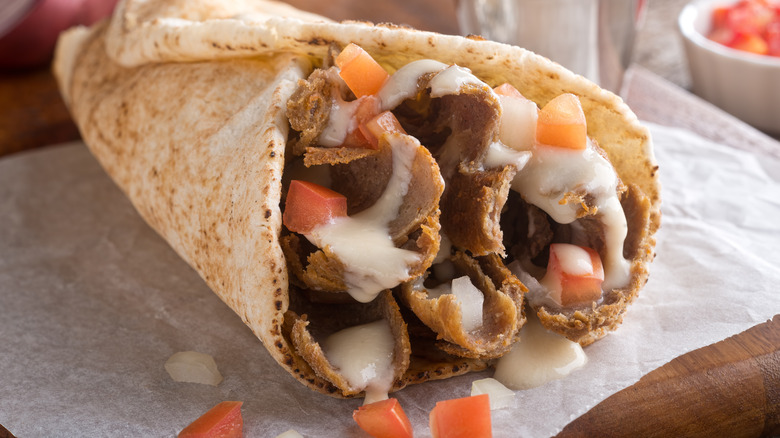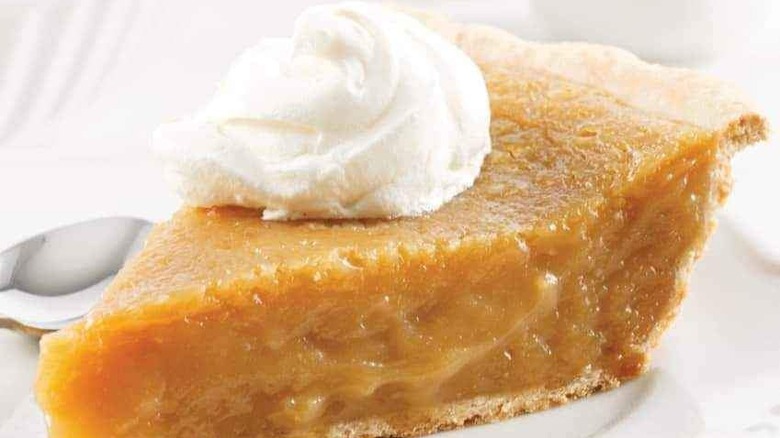Iconic Canadian Foods You Need To Try Before You Die
While its enticing cuisine may not be the first thing that comes to mind when one thinks about Canada (hockey, moose, Mounties, comedy, and politeness tend to get priority), that doesn't mean there isn't a delicious plethora of food and beverage items from the Great White North just waiting to be discovered.
Canada offers a rich food tradition with plenty of offerings that will make your Northern Lights twinkle. These dishes include a mix of items that are familiar to American palates as well as majorly mouth-watering culinary secrets that rarely make their way across the border. But we're here to let the caribou out of the bag. From french fries topped with gravy and cheese curds (we could be happy with this alone!) to sweet decadent pastries, sinfully smoked meats to a cocktail that some swear will cure a hangover, these are the Canadian foods that need to be included on your culinary bucket list.
Poutine
One of the most famous Canadian food exports is undoubtedly poutine. This Quebecois dish consists of french fries topped with cheese curds and gravy (or is it poutine sauce?). The demand for poutine is so immense that famous fast food chains like McDonalds and Burger King have included it in their Canadian menus, and there is even an annual Major League poutine eating contest. In fact, it is such an absolute staple of Canadian history and culture, that the dish is acknowledged by many as Canada's national food, per Canadian Affair.
Its origins are hotly debated and wrestled over, with many restaurants obviously wanting to claim to be the spot that started the sensation. Possibilities include Warwick's Le Lutin Qui Rit ("The Laughing Elf" in English) and Drummondville's Le Roy Jucep (via The Food Girl in Town) as well as a number of restaurants in the Nicolet and Saint-Hyacinth regions which are known for their cheese curd production. It seems wrong to fight so when there's just so much deep fried, gravy covered, cheesy goodness to go around.
Tourtiere
Almost every country in the world has some version of a meat pie. In Britain, steak and kidney pies are ubiquitous while the Scots are known for haggis. The Greeks have their kreatopita, xian bing is big in China, while empanadas are the stuffed pastry of choice throughout Latin America. Americans, of course, are big fans of a good ol' fashioned chicken pot pie. And as for Canadians, they love a good tourtière.
Tourtière is a baked meat pie that consists of a bottom layer of pie pastry, a meat filling center, and is topped with another covering of pie pastry, before being baked in an oven. According to Food Bloggers of Canada the meats used for tourtière are traditionally pheasant, rabbit, moose, or pigeon, though more contemporary versions tend to include pork, beef, and/or veal. Cook's Info reports that tourtière is traditionally served during the holidays — the pie's spice mix, which includes cinnamon, clove, allspice, and nutmeg, is certainly seasonally appropriate.
Our favorite tradition having to do with the tourtière is that it's meant to be shared with family and friends. It doesn't get much more Canadian than that, eh?
Maple Syrup
It's hard to think of Canadian food stuffs and not have maple syrup come to mind in some form. The maple tree is so famous and ubiquitous in Canada, that the country's very flag features its leaf, bright and beaming, the center of attention. And deservedly so. According to Bloomberg, as of 2020, Canada is the world's leading producer and exporter of maple products, accounting for 79% of the global market.
Maple syrup and maple sugar products are created from the gathering and cooking down of maple tree sap. (The sap is collected by the tapping of the trees.) These techniques were originally discovered by the Indigenous peoples, and adopted later by French settlers. The Canadian Encyclopedia explains that the first documented uses of maple sap in this way were by settlers André Thevet and Marc Lescarbot in writings that date back to the mid-16th.
Maple syrup is so prevalent in Canada, that it's sneaked its way into many otherwise traditionally unsweetened food and beverage items such as tea bags and protein powder, per Buzzfeed. Of course, its hand in the dessert industry is immense as well, with treats like maple cookies and maple candies playing a major part in the Canadian dessert world.
Beaver Tails
The beaver tail is a Canadian national treasure. Sold and enjoyed across the country, from Vancouver to Nova Scotia, it seems most Canadians have a soft spot for this chewy treat made from hand-stretched wheat dough (via Culture Trip). While the traditional version is topped with a simple dusting of cinnamon and sugar, over the years, the beaver tail has evolved into more than just a dessert, depending on where in Canada you might be.
For example, according to Culture Trip, in Vancouver, you can get a salmon tail, which substitutes the standard sweet topping for a combination of cream cheese and capers. In Mont Tremblant, you can pick up a ham-and-cheese tail or a steak-topped tail. A specialty of Halifax is the Triple Trip Beaver Tail, which is topped with peanut butter, chocolate, and Reese's Pieces. There's even a popular Canadian restaurant chain, BeaverTails, which has been serving up this iconic indulgence since 1978!
Butter Tarts
Oh Canada, does this sugary sweet dessert deserve its highly esteemed reputation. A traditional Canadian butter tart is a tiny pastry with a wonderfully runny or semi-solid (this point is very passionately debated) center. The filling is made from butter, sugar, syrup, and egg, then poured into a pastry shell and baked until the filling is semi-solid (or runny — depending on your preference) with a crunchy top.
According to Food Bloggers of Canada, "The Women's Auxiliary of the Royal Victoria Hospital Cookbook" contains the first documented recipe for butter tarts. Published in 1900 in Barrie, Ontario, this seems to be the source that started it all. The original versions were made with maple sugar, freshly churned butter, and dried fruit such as raisins or currants (though, whether these should be included in contemporary versions is also hotly debated). They gained popularity in the 1920s, and the rest is just beautifully buttery history.
Nanaimo Bars
Much like the butter tart, the Nanaimo bar is yet another of Canada's deliciously decadent, rich desserts. Constructed of a graham cracker crumb and shredded coconut base, a custard-flavored butter icing in the center, and a chocolate ganache on top, the Nanaimo bar is a three-layered, no-bake delight that is famous throughout the country.
The Nanaimo bar is so popular, in fact, that its origins are hotly disputed. Everyone wants a piece of the three layer, coconutty credit. And who can blame them? It's such a passed down story, that even a local RE/MAX agency recounts the history of the bar on their website. According to legend, a group of friends from Nanaimo, British Columbia found the recipe in the Vancouver Sun. At the time, the recipe was titled "chocolate fridge cake," and the friends changed the name to Nanaimo bars after their town. The recipe made its way throughout the province's communities, circulated by housewives and home bakers. While this story is unconfirmed, it has a nice ring to it, so we'll go with this version of how Nanaimo bars came to be. MonteCristo Magazine reports that the bars enjoyed a rise to fame during Expo 86 in Vancouver, and have been a national jewel ever since.
Montreal Smoked Meat
Montreal's travel website describes their city's signature smoked meat as a smoked beef brisket that's often piled high between rye bread, and served with mustard and a fresh dill pickle. Unlike New York-style pastrami, Montreal smoked meat uses the entire brisket, while the meat for its NYC deli equivalent is taken from the much leaner navel cut. The spice mix is also different, with pastrami heavier on the sugar and Montreal smoked meat relying more on black peppercorn and other spices (via The Canadian Encyclopedia).
Because of its intense popularity, Montreal smoked meat is now popping up in many other culinary preparations beyond the sandwich, such as atop poutine and as a pizza topping, according to The Canadian Encyclopedia. Many deli counters and restaurants in Montreal all claim to have the best version, but this is a subject that gets a lot of debate. We think the only responsible choice is to hop on a plane to Montreal and make the call yourself.
Bannock
As with meat pies, it would be hard to find a country that doesn't have their own version of a flatbread. Just think of all of the deliciously unleavened options! The tasty, carb-filled world we live in has given us lavash, matzah, naan, pita, and tortillas, to name only a few. And in Canada, it's bannock. Food Bloggers of Canada tells us that First Nations peoples adopted bannock from Scottish fur traders long ago when it was made from ground plant bulbs and cooked on an open flame. The original version was much denser and flatter before it evolved into the wheat flour-based version that's so popular today.
While there are multiple recipes available, Bannock is essentially unleavened bread that's shaped into oval pieces before being baked or fried, usually in a cast-iron pan. Much like the popularity of beaver tails, part of the appeal of Bannock is its versatility to be a perfect base for breakfast to dessert, and anything in between.
Saskatoon Berry Pie
Jumping on into the sugar-coated fun with the other delicious desserts on our list, Saskatoon berry pie is a regional trademark of Western Canada, per Taste Atlas. The site reports that the tasty appeal of these berries, which grow from the Plains to the coast of British Columbia, dates all the way back to their use by the Indigenous People of Canada. Finding many uses for the Saskatoon, they were often ground into a paste and dried for winter storage. Now, these berries have made a name for themselves in the Canadian pastry world, and interestingly, are protected by the International Ark of Taste (via Slow Food Saskatoon).
Saskatoon berries are similar to blueberries in both appearance and flavor, but harder and have smaller seeds. They are also drier and earthier in flavor. Served in many Saskatchewan and Alberta pastry shops and confectionaries, famous Saskatoon berry pie is made from flour, pastry, butter, eggs, and, of course Saskatoon berries (via Taste Atlas). Often paired with vanilla ice cream or whipped cream, this pie is a Canadian culinary treasure.
Peameal (Canadian) Bacon
If you grew up in the United States, chances are, you know this product as Canadian bacon. Unlike its fattier, American-loved cousin which consists of strips of belly, Canadian, or, peameal bacon as it's called by our northern neighbors, is lean pork loin that's been brined and rolled in cornmeal. According to The Kitchen Project, during the mid-1800s, Canada would export its pork to England, which was experiencing a shortage at the time. For preservation purposes, the pork was rolled in ground yellow peas, which is where the name "peameal" comes from. Some time later, the ground peas were swapped for cornmeal, but the name stuck — at least in Canada (where it is also referred to as "back bacon"). For Americans, it will always be Canadian bacon.
From eggs benedict to baked beans, the possibilities for peameal bacon are endless. And you may already be a fan, having just been calling it by the "wrong" name all this time like we have.
Caesar Cocktail
While not technically a food, the classically Canadian Caesar cocktail is often served with so many edible garnishes, we decided it was safe to count it, especially since Parker's Hangover Tonic claims that this is the magic potion to cure a hangover. Sometimes known as the Bloody Caesar, this drink is made of vodka, clam juice, tomato juice, spices and Worcestershire sauce. Typically served in a highball glass that's been rimmed with celery salt and topped with any number of garnishes from celery, olives, lime wedges, pickles, to even shrimp or bacon. There are even versions complete with hot wings and onion rings (via Chatelaine).
According to The Canadian Encyclopedia, the Caesar was invented by restaurant worker Walter Chell in 1969. Chell was an employee of The Calgary Inn, and as they prepared to open a new restaurant, Marco's, Chell was asked to create a cocktail to commemorate the occasion.
Press Reader reports that in 2006, the Caesar was ranked 13 on the CBC TV series "The Greatest Canadian Invention." In 2009, the cocktail received a most prestigious honor for its 40th anniversary. David Bronconnier, mayor of Calgary, declared that the Thursday before Victoria Day every May would be Caesar Day. Later that year, Canada Dry Mott's launched an online petition to make the Caesar Canada's official cocktail. According to National Post, Canadians order more than 350 million Caesar cocktails every year. All we can say is, "cheers!" But maybe hold the onion rings.
Montreal Bagels
If you're from the states, you probably think of New York when bagels come to mind. And that would be fair. The Big Apple has some of the best bagels in the world. Chewy, but never doughy, beautifully crusted with a glistening sheen, delicately tangy, but never overpowering, New York bagels have earned their glowing reputation. But upon further investigation and research, you'll find that New York bagels have a worthy rival: Montreal bagels.
While the two types have their similarities, Bagel Time explains that the main difference is in the cooking process. First, Montreal Bagels are boiled in water that has been sweetened, usually with honey, whereas New York-style bagels are boiled without this sweet addition. Montreal Bagels are also traditionally baked in a wood fired oven, resulting in a richer, more flavorful crust. They are often a bit smaller than the sometimes massive New York Bagels, and traditionally studded with sesame and/or poppy seeds.
Another notable difference is topping choice. While New Yorkers, and lovers of New York-style bagels tend to top their bagels high with everything from cream cheese to fried eggs to lox, Canadians often enjoy their Montreal Bagels plain, without adornment. The delicious honey-induced sweetness makes any other topping seem superfluous.
Donair
If you're a lover of a good, meaty gyro stuffed with your favorite fillings and wonderfully drippy tzatziki sauce, this spin-off sandwich is a must-try. According to How Stuff Works, the Donair (often referred to as the Halifax Donair), was born from one Greek immigrant's imaginative blending of his native country's flavors with those of his new country. Chef Peter Gamoulakos subbed the traditional lamb for beef, and replaced the tzatziki sauce with a new invention he dubbed "donair sauce," which is arguably the most well loved part of this bizarrely wonderful sandwich. A uniquely sweet blend of evaporated milk, vinegar, garlic powder, and sugar, this sauce was an instant hit.
The Donair was such a success, in fact, that in 1973, Gamoulakos opened King of Donair, a chain restaurant specializing in his unique creation. Still going strong, King of Donair is regularly serving up many variations of the original sandwich to hungry Canadians in several locations across the country.
Tarte au Sucre (Sugar Pie)
There are a lot of sweet treats on this list, and for that reason we're having a difficult time not booking ourselves a one-way ticket to the land of maple syrup. Cue our next Canadian confection, the Tarte au Sucre (sugar pie). Simple in all the best ways, this dessert (which happens to be a favorite of Canadian-native and "Top Chef" judge Gail Simmons) is filled with a mixture of cream, maple syrup, sugar, and lots of butter, then baked to golden perfection.
A holiday tradition in Quebec, The Spruce Eats tells us that many French-Canadian families consider the tarte au sucre to be an integral part of their holiday meals and traditions. Served at the end of a festive feast, a slice of sugar pie is often simply topped with a luscious dollop of whipped cream, needing no further adornment.
All we can say is, "sugar pie, honey bunch, you know that we love you!" Sorry, we couldn't help ourselves.
